Strategic Management: Process, Models, and Change Management
VerifiedAdded on 2023/01/05
|9
|2525
|72
AI Summary
This assignment explores the process of strategic management, including the assessment of strategies used by organizations. It also evaluates critical models and tools used in determining strategy and discusses the importance of change management. The application of these concepts is demonstrated through a case study of Tesco.
Contribute Materials
Your contribution can guide someone’s learning journey. Share your
documents today.
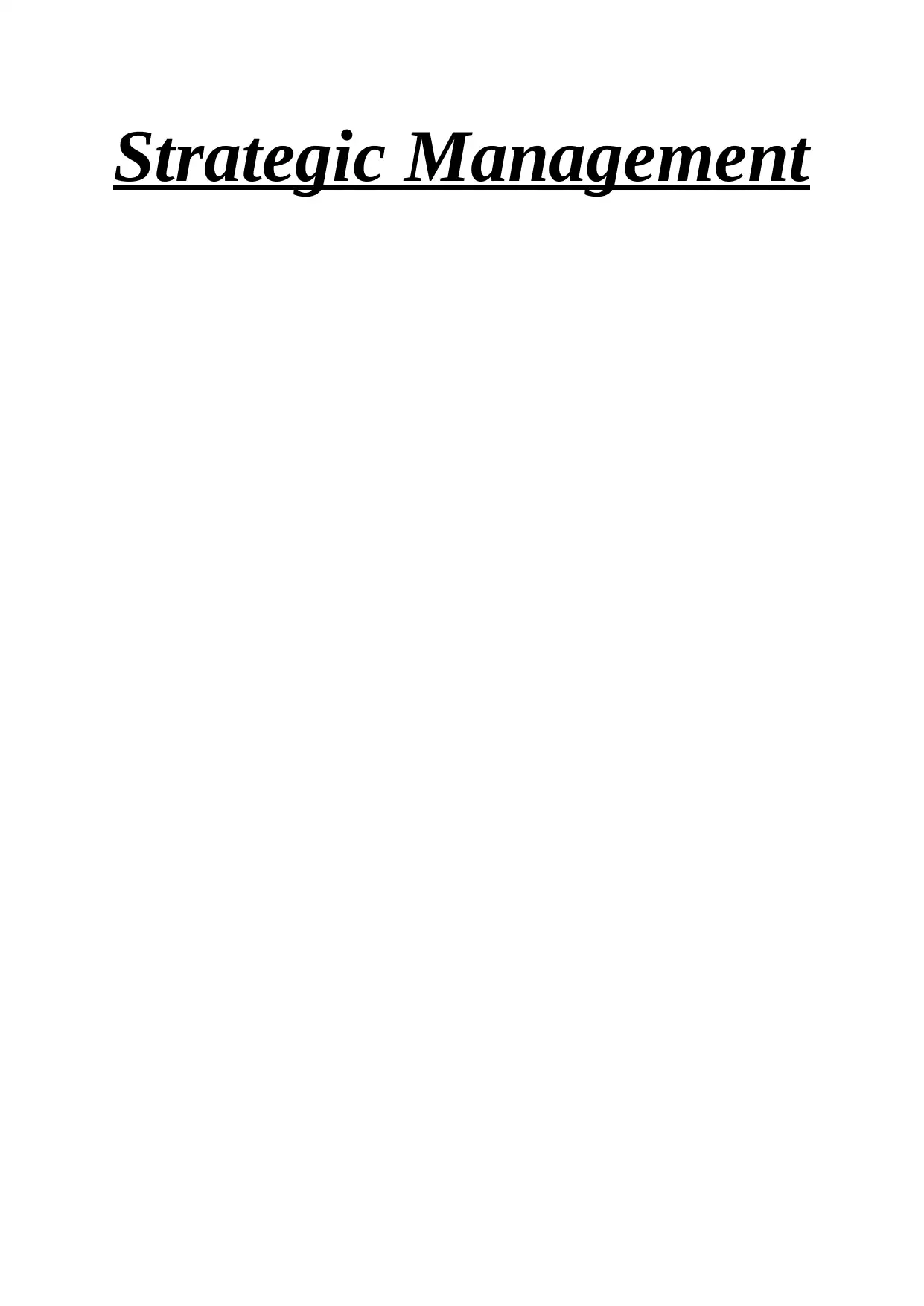
Strategic Management
Secure Best Marks with AI Grader
Need help grading? Try our AI Grader for instant feedback on your assignments.
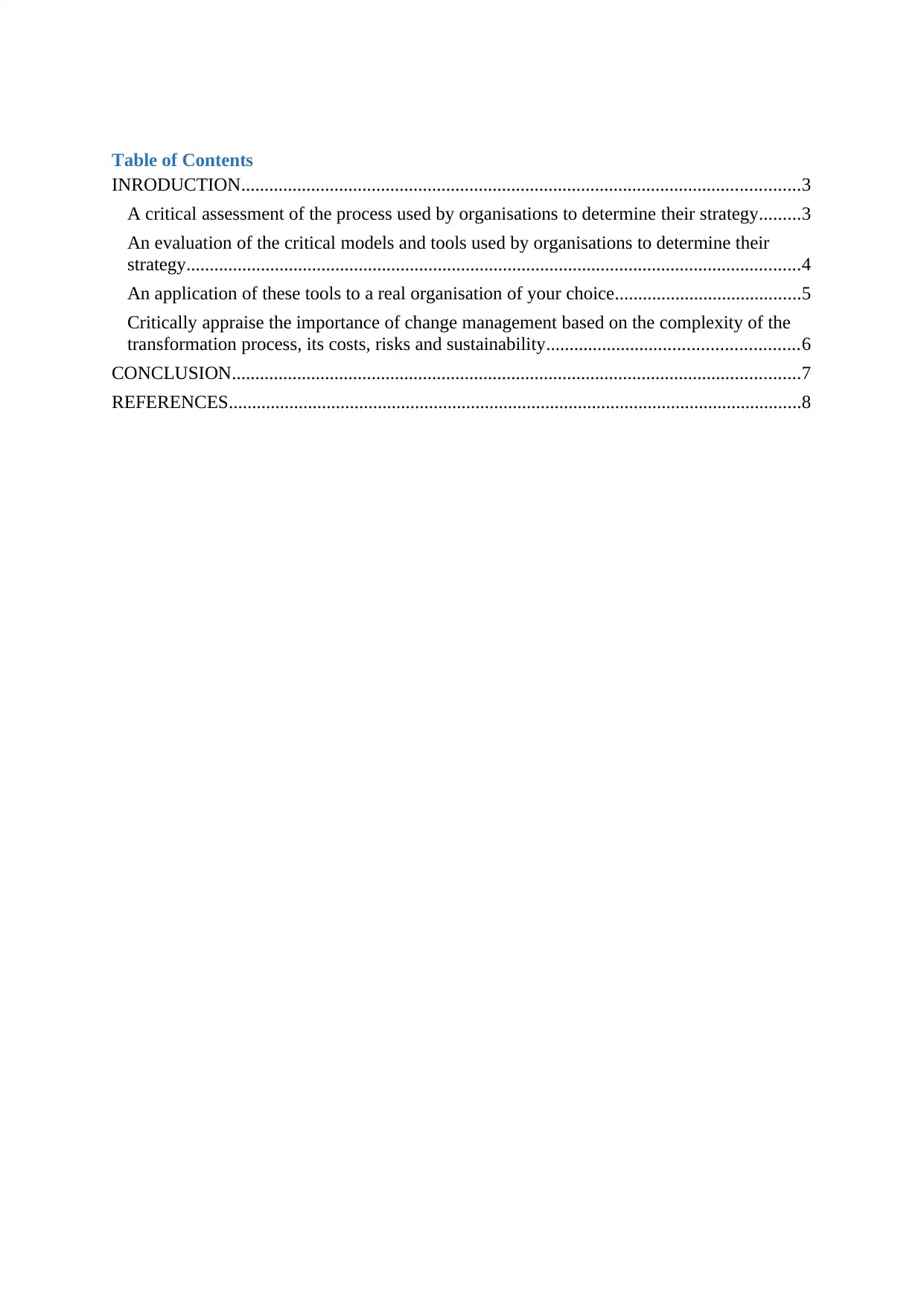
Table of Contents
INRODUCTION........................................................................................................................3
A critical assessment of the process used by organisations to determine their strategy.........3
An evaluation of the critical models and tools used by organisations to determine their
strategy....................................................................................................................................4
An application of these tools to a real organisation of your choice........................................5
Critically appraise the importance of change management based on the complexity of the
transformation process, its costs, risks and sustainability......................................................6
CONCLUSION..........................................................................................................................7
REFERENCES...........................................................................................................................8
INRODUCTION........................................................................................................................3
A critical assessment of the process used by organisations to determine their strategy.........3
An evaluation of the critical models and tools used by organisations to determine their
strategy....................................................................................................................................4
An application of these tools to a real organisation of your choice........................................5
Critically appraise the importance of change management based on the complexity of the
transformation process, its costs, risks and sustainability......................................................6
CONCLUSION..........................................................................................................................7
REFERENCES...........................................................................................................................8
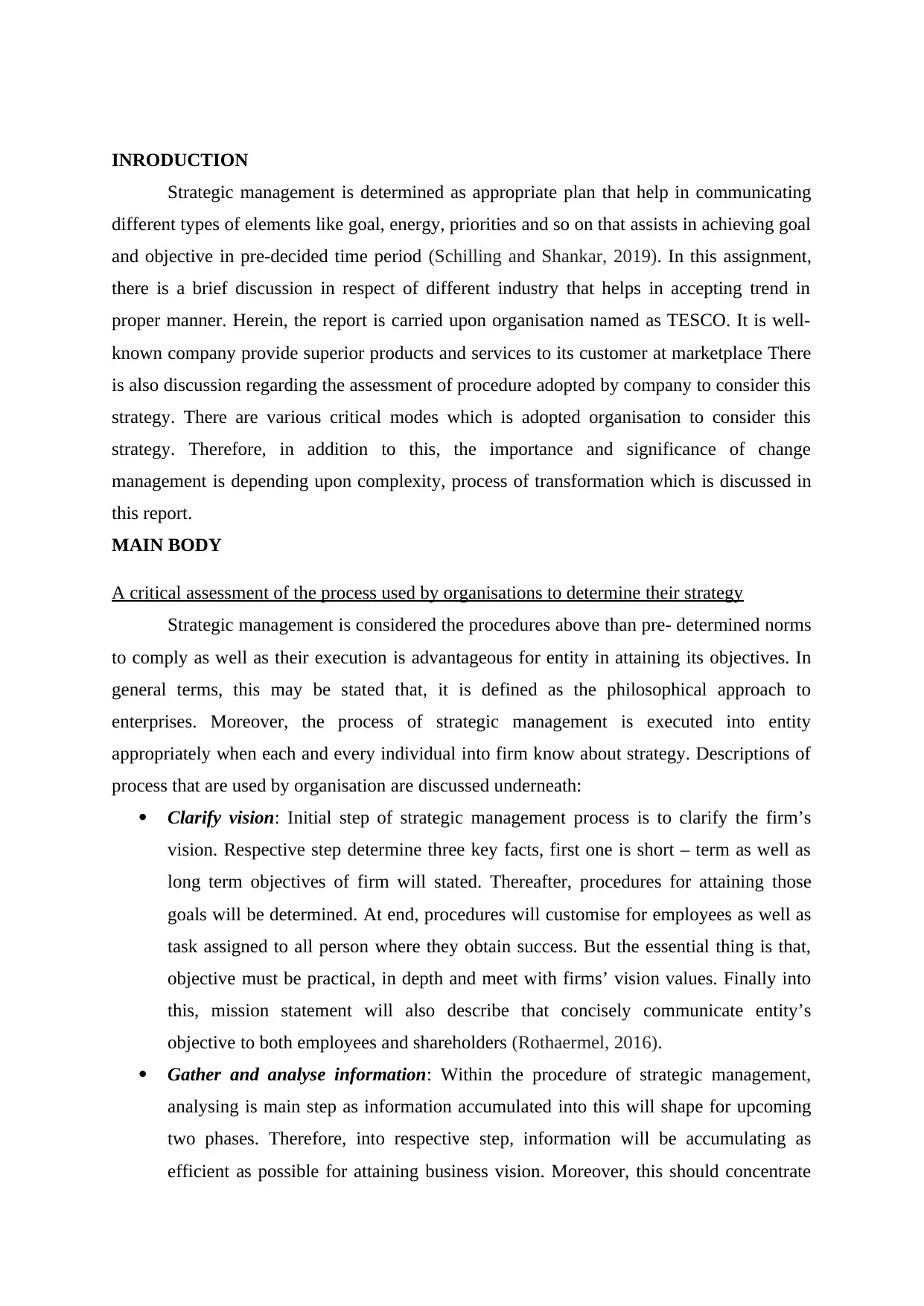
INRODUCTION
Strategic management is determined as appropriate plan that help in communicating
different types of elements like goal, energy, priorities and so on that assists in achieving goal
and objective in pre-decided time period (Schilling and Shankar, 2019). In this assignment,
there is a brief discussion in respect of different industry that helps in accepting trend in
proper manner. Herein, the report is carried upon organisation named as TESCO. It is well-
known company provide superior products and services to its customer at marketplace There
is also discussion regarding the assessment of procedure adopted by company to consider this
strategy. There are various critical modes which is adopted organisation to consider this
strategy. Therefore, in addition to this, the importance and significance of change
management is depending upon complexity, process of transformation which is discussed in
this report.
MAIN BODY
A critical assessment of the process used by organisations to determine their strategy
Strategic management is considered the procedures above than pre- determined norms
to comply as well as their execution is advantageous for entity in attaining its objectives. In
general terms, this may be stated that, it is defined as the philosophical approach to
enterprises. Moreover, the process of strategic management is executed into entity
appropriately when each and every individual into firm know about strategy. Descriptions of
process that are used by organisation are discussed underneath:
Clarify vision: Initial step of strategic management process is to clarify the firm’s
vision. Respective step determine three key facts, first one is short – term as well as
long term objectives of firm will stated. Thereafter, procedures for attaining those
goals will be determined. At end, procedures will customise for employees as well as
task assigned to all person where they obtain success. But the essential thing is that,
objective must be practical, in depth and meet with firms’ vision values. Finally into
this, mission statement will also describe that concisely communicate entity’s
objective to both employees and shareholders (Rothaermel, 2016).
Gather and analyse information: Within the procedure of strategic management,
analysing is main step as information accumulated into this will shape for upcoming
two phases. Therefore, into respective step, information will be accumulating as
efficient as possible for attaining business vision. Moreover, this should concentrate
Strategic management is determined as appropriate plan that help in communicating
different types of elements like goal, energy, priorities and so on that assists in achieving goal
and objective in pre-decided time period (Schilling and Shankar, 2019). In this assignment,
there is a brief discussion in respect of different industry that helps in accepting trend in
proper manner. Herein, the report is carried upon organisation named as TESCO. It is well-
known company provide superior products and services to its customer at marketplace There
is also discussion regarding the assessment of procedure adopted by company to consider this
strategy. There are various critical modes which is adopted organisation to consider this
strategy. Therefore, in addition to this, the importance and significance of change
management is depending upon complexity, process of transformation which is discussed in
this report.
MAIN BODY
A critical assessment of the process used by organisations to determine their strategy
Strategic management is considered the procedures above than pre- determined norms
to comply as well as their execution is advantageous for entity in attaining its objectives. In
general terms, this may be stated that, it is defined as the philosophical approach to
enterprises. Moreover, the process of strategic management is executed into entity
appropriately when each and every individual into firm know about strategy. Descriptions of
process that are used by organisation are discussed underneath:
Clarify vision: Initial step of strategic management process is to clarify the firm’s
vision. Respective step determine three key facts, first one is short – term as well as
long term objectives of firm will stated. Thereafter, procedures for attaining those
goals will be determined. At end, procedures will customise for employees as well as
task assigned to all person where they obtain success. But the essential thing is that,
objective must be practical, in depth and meet with firms’ vision values. Finally into
this, mission statement will also describe that concisely communicate entity’s
objective to both employees and shareholders (Rothaermel, 2016).
Gather and analyse information: Within the procedure of strategic management,
analysing is main step as information accumulated into this will shape for upcoming
two phases. Therefore, into respective step, information will be accumulating as
efficient as possible for attaining business vision. Moreover, this should concentrate
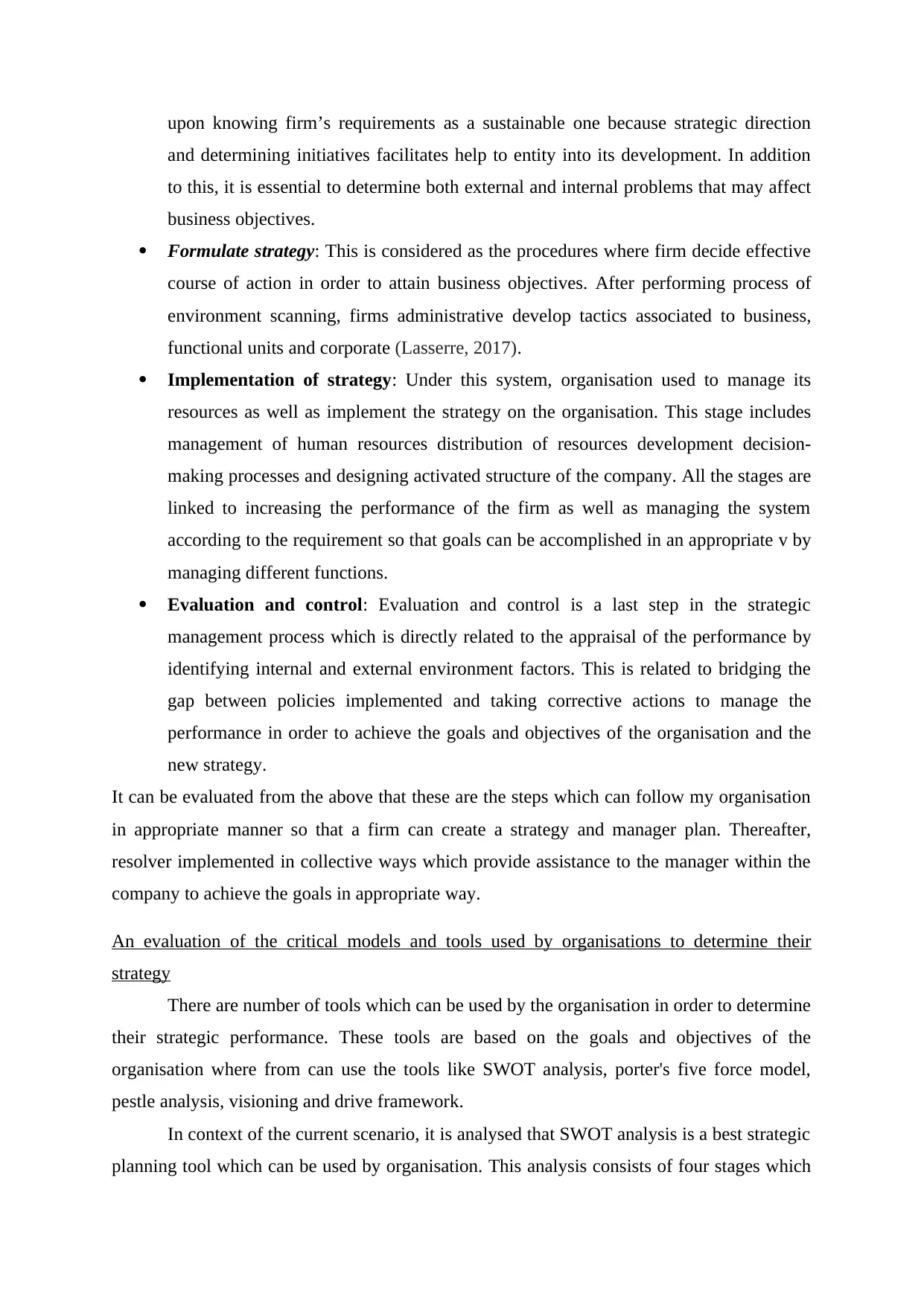
upon knowing firm’s requirements as a sustainable one because strategic direction
and determining initiatives facilitates help to entity into its development. In addition
to this, it is essential to determine both external and internal problems that may affect
business objectives.
Formulate strategy: This is considered as the procedures where firm decide effective
course of action in order to attain business objectives. After performing process of
environment scanning, firms administrative develop tactics associated to business,
functional units and corporate (Lasserre, 2017).
Implementation of strategy: Under this system, organisation used to manage its
resources as well as implement the strategy on the organisation. This stage includes
management of human resources distribution of resources development decision-
making processes and designing activated structure of the company. All the stages are
linked to increasing the performance of the firm as well as managing the system
according to the requirement so that goals can be accomplished in an appropriate v by
managing different functions.
Evaluation and control: Evaluation and control is a last step in the strategic
management process which is directly related to the appraisal of the performance by
identifying internal and external environment factors. This is related to bridging the
gap between policies implemented and taking corrective actions to manage the
performance in order to achieve the goals and objectives of the organisation and the
new strategy.
It can be evaluated from the above that these are the steps which can follow my organisation
in appropriate manner so that a firm can create a strategy and manager plan. Thereafter,
resolver implemented in collective ways which provide assistance to the manager within the
company to achieve the goals in appropriate way.
An evaluation of the critical models and tools used by organisations to determine their
strategy
There are number of tools which can be used by the organisation in order to determine
their strategic performance. These tools are based on the goals and objectives of the
organisation where from can use the tools like SWOT analysis, porter's five force model,
pestle analysis, visioning and drive framework.
In context of the current scenario, it is analysed that SWOT analysis is a best strategic
planning tool which can be used by organisation. This analysis consists of four stages which
and determining initiatives facilitates help to entity into its development. In addition
to this, it is essential to determine both external and internal problems that may affect
business objectives.
Formulate strategy: This is considered as the procedures where firm decide effective
course of action in order to attain business objectives. After performing process of
environment scanning, firms administrative develop tactics associated to business,
functional units and corporate (Lasserre, 2017).
Implementation of strategy: Under this system, organisation used to manage its
resources as well as implement the strategy on the organisation. This stage includes
management of human resources distribution of resources development decision-
making processes and designing activated structure of the company. All the stages are
linked to increasing the performance of the firm as well as managing the system
according to the requirement so that goals can be accomplished in an appropriate v by
managing different functions.
Evaluation and control: Evaluation and control is a last step in the strategic
management process which is directly related to the appraisal of the performance by
identifying internal and external environment factors. This is related to bridging the
gap between policies implemented and taking corrective actions to manage the
performance in order to achieve the goals and objectives of the organisation and the
new strategy.
It can be evaluated from the above that these are the steps which can follow my organisation
in appropriate manner so that a firm can create a strategy and manager plan. Thereafter,
resolver implemented in collective ways which provide assistance to the manager within the
company to achieve the goals in appropriate way.
An evaluation of the critical models and tools used by organisations to determine their
strategy
There are number of tools which can be used by the organisation in order to determine
their strategic performance. These tools are based on the goals and objectives of the
organisation where from can use the tools like SWOT analysis, porter's five force model,
pestle analysis, visioning and drive framework.
In context of the current scenario, it is analysed that SWOT analysis is a best strategic
planning tool which can be used by organisation. This analysis consists of four stages which
Secure Best Marks with AI Grader
Need help grading? Try our AI Grader for instant feedback on your assignments.
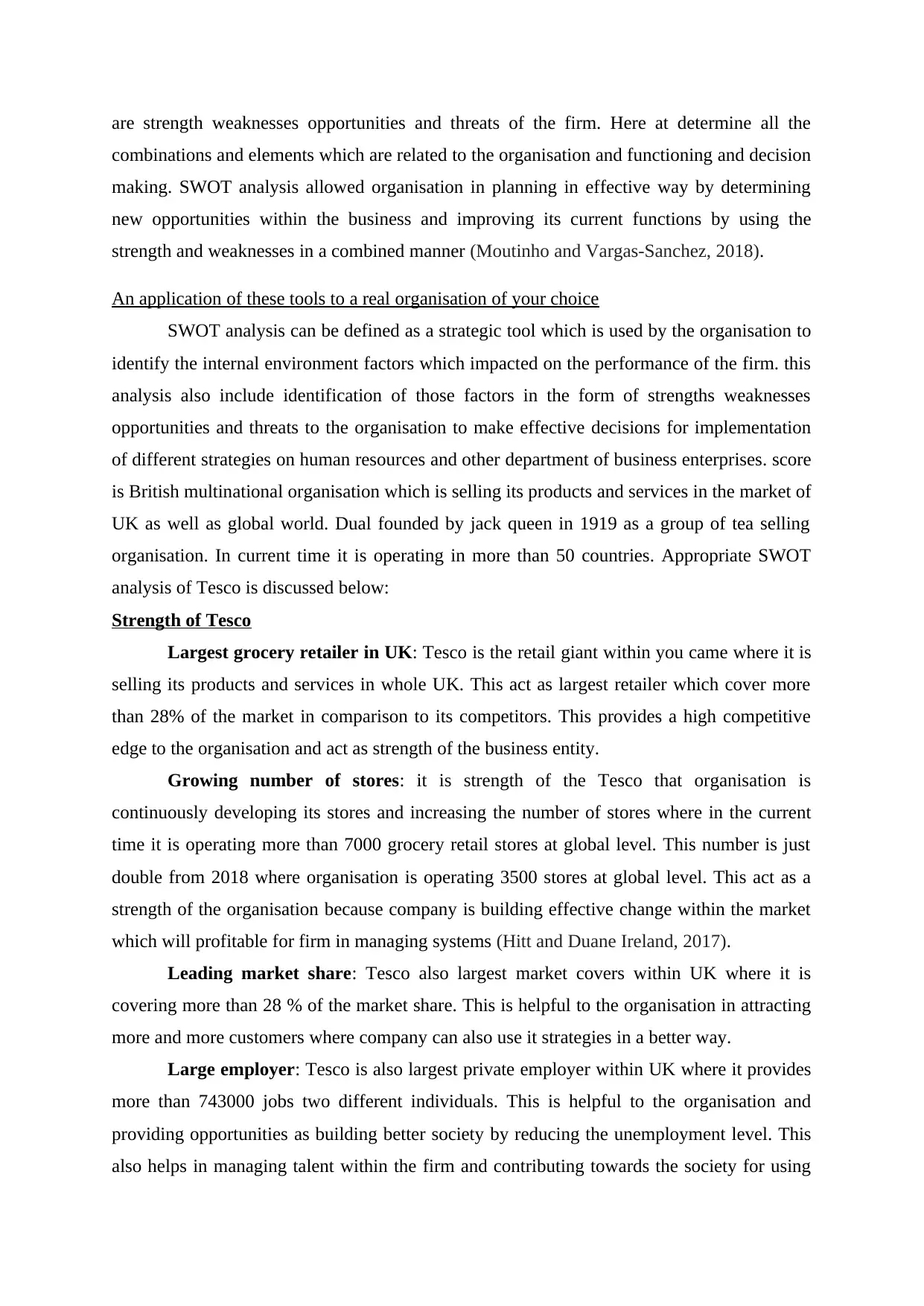
are strength weaknesses opportunities and threats of the firm. Here at determine all the
combinations and elements which are related to the organisation and functioning and decision
making. SWOT analysis allowed organisation in planning in effective way by determining
new opportunities within the business and improving its current functions by using the
strength and weaknesses in a combined manner (Moutinho and Vargas-Sanchez, 2018).
An application of these tools to a real organisation of your choice
SWOT analysis can be defined as a strategic tool which is used by the organisation to
identify the internal environment factors which impacted on the performance of the firm. this
analysis also include identification of those factors in the form of strengths weaknesses
opportunities and threats to the organisation to make effective decisions for implementation
of different strategies on human resources and other department of business enterprises. score
is British multinational organisation which is selling its products and services in the market of
UK as well as global world. Dual founded by jack queen in 1919 as a group of tea selling
organisation. In current time it is operating in more than 50 countries. Appropriate SWOT
analysis of Tesco is discussed below:
Strength of Tesco
Largest grocery retailer in UK: Tesco is the retail giant within you came where it is
selling its products and services in whole UK. This act as largest retailer which cover more
than 28% of the market in comparison to its competitors. This provides a high competitive
edge to the organisation and act as strength of the business entity.
Growing number of stores: it is strength of the Tesco that organisation is
continuously developing its stores and increasing the number of stores where in the current
time it is operating more than 7000 grocery retail stores at global level. This number is just
double from 2018 where organisation is operating 3500 stores at global level. This act as a
strength of the organisation because company is building effective change within the market
which will profitable for firm in managing systems (Hitt and Duane Ireland, 2017).
Leading market share: Tesco also largest market covers within UK where it is
covering more than 28 % of the market share. This is helpful to the organisation in attracting
more and more customers where company can also use it strategies in a better way.
Large employer: Tesco is also largest private employer within UK where it provides
more than 743000 jobs two different individuals. This is helpful to the organisation and
providing opportunities as building better society by reducing the unemployment level. This
also helps in managing talent within the firm and contributing towards the society for using
combinations and elements which are related to the organisation and functioning and decision
making. SWOT analysis allowed organisation in planning in effective way by determining
new opportunities within the business and improving its current functions by using the
strength and weaknesses in a combined manner (Moutinho and Vargas-Sanchez, 2018).
An application of these tools to a real organisation of your choice
SWOT analysis can be defined as a strategic tool which is used by the organisation to
identify the internal environment factors which impacted on the performance of the firm. this
analysis also include identification of those factors in the form of strengths weaknesses
opportunities and threats to the organisation to make effective decisions for implementation
of different strategies on human resources and other department of business enterprises. score
is British multinational organisation which is selling its products and services in the market of
UK as well as global world. Dual founded by jack queen in 1919 as a group of tea selling
organisation. In current time it is operating in more than 50 countries. Appropriate SWOT
analysis of Tesco is discussed below:
Strength of Tesco
Largest grocery retailer in UK: Tesco is the retail giant within you came where it is
selling its products and services in whole UK. This act as largest retailer which cover more
than 28% of the market in comparison to its competitors. This provides a high competitive
edge to the organisation and act as strength of the business entity.
Growing number of stores: it is strength of the Tesco that organisation is
continuously developing its stores and increasing the number of stores where in the current
time it is operating more than 7000 grocery retail stores at global level. This number is just
double from 2018 where organisation is operating 3500 stores at global level. This act as a
strength of the organisation because company is building effective change within the market
which will profitable for firm in managing systems (Hitt and Duane Ireland, 2017).
Leading market share: Tesco also largest market covers within UK where it is
covering more than 28 % of the market share. This is helpful to the organisation in attracting
more and more customers where company can also use it strategies in a better way.
Large employer: Tesco is also largest private employer within UK where it provides
more than 743000 jobs two different individuals. This is helpful to the organisation and
providing opportunities as building better society by reducing the unemployment level. This
also helps in managing talent within the firm and contributing towards the society for using
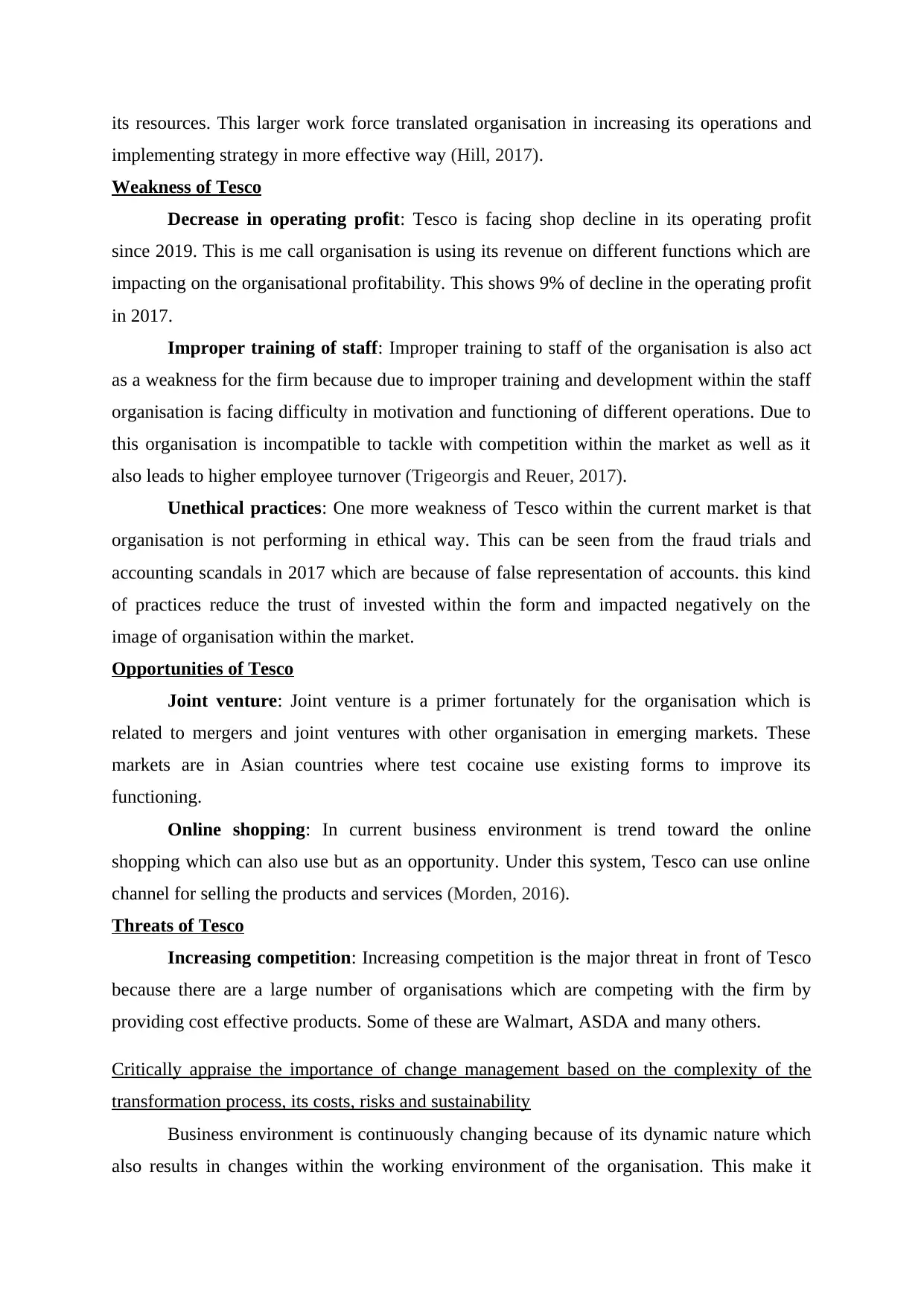
its resources. This larger work force translated organisation in increasing its operations and
implementing strategy in more effective way (Hill, 2017).
Weakness of Tesco
Decrease in operating profit: Tesco is facing shop decline in its operating profit
since 2019. This is me call organisation is using its revenue on different functions which are
impacting on the organisational profitability. This shows 9% of decline in the operating profit
in 2017.
Improper training of staff: Improper training to staff of the organisation is also act
as a weakness for the firm because due to improper training and development within the staff
organisation is facing difficulty in motivation and functioning of different operations. Due to
this organisation is incompatible to tackle with competition within the market as well as it
also leads to higher employee turnover (Trigeorgis and Reuer, 2017).
Unethical practices: One more weakness of Tesco within the current market is that
organisation is not performing in ethical way. This can be seen from the fraud trials and
accounting scandals in 2017 which are because of false representation of accounts. this kind
of practices reduce the trust of invested within the form and impacted negatively on the
image of organisation within the market.
Opportunities of Tesco
Joint venture: Joint venture is a primer fortunately for the organisation which is
related to mergers and joint ventures with other organisation in emerging markets. These
markets are in Asian countries where test cocaine use existing forms to improve its
functioning.
Online shopping: In current business environment is trend toward the online
shopping which can also use but as an opportunity. Under this system, Tesco can use online
channel for selling the products and services (Morden, 2016).
Threats of Tesco
Increasing competition: Increasing competition is the major threat in front of Tesco
because there are a large number of organisations which are competing with the firm by
providing cost effective products. Some of these are Walmart, ASDA and many others.
Critically appraise the importance of change management based on the complexity of the
transformation process, its costs, risks and sustainability
Business environment is continuously changing because of its dynamic nature which
also results in changes within the working environment of the organisation. This make it
implementing strategy in more effective way (Hill, 2017).
Weakness of Tesco
Decrease in operating profit: Tesco is facing shop decline in its operating profit
since 2019. This is me call organisation is using its revenue on different functions which are
impacting on the organisational profitability. This shows 9% of decline in the operating profit
in 2017.
Improper training of staff: Improper training to staff of the organisation is also act
as a weakness for the firm because due to improper training and development within the staff
organisation is facing difficulty in motivation and functioning of different operations. Due to
this organisation is incompatible to tackle with competition within the market as well as it
also leads to higher employee turnover (Trigeorgis and Reuer, 2017).
Unethical practices: One more weakness of Tesco within the current market is that
organisation is not performing in ethical way. This can be seen from the fraud trials and
accounting scandals in 2017 which are because of false representation of accounts. this kind
of practices reduce the trust of invested within the form and impacted negatively on the
image of organisation within the market.
Opportunities of Tesco
Joint venture: Joint venture is a primer fortunately for the organisation which is
related to mergers and joint ventures with other organisation in emerging markets. These
markets are in Asian countries where test cocaine use existing forms to improve its
functioning.
Online shopping: In current business environment is trend toward the online
shopping which can also use but as an opportunity. Under this system, Tesco can use online
channel for selling the products and services (Morden, 2016).
Threats of Tesco
Increasing competition: Increasing competition is the major threat in front of Tesco
because there are a large number of organisations which are competing with the firm by
providing cost effective products. Some of these are Walmart, ASDA and many others.
Critically appraise the importance of change management based on the complexity of the
transformation process, its costs, risks and sustainability
Business environment is continuously changing because of its dynamic nature which
also results in changes within the working environment of the organisation. This make it
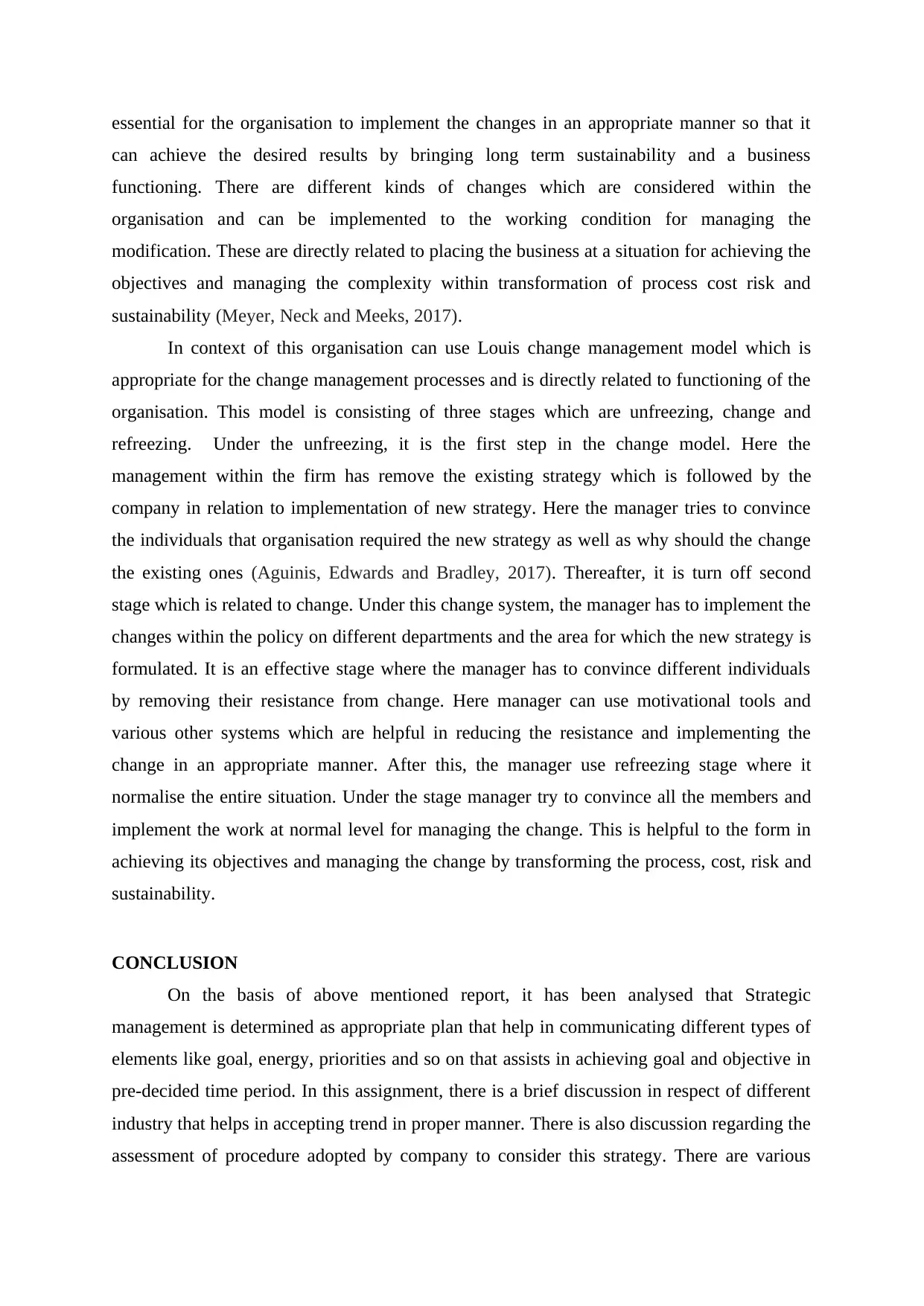
essential for the organisation to implement the changes in an appropriate manner so that it
can achieve the desired results by bringing long term sustainability and a business
functioning. There are different kinds of changes which are considered within the
organisation and can be implemented to the working condition for managing the
modification. These are directly related to placing the business at a situation for achieving the
objectives and managing the complexity within transformation of process cost risk and
sustainability (Meyer, Neck and Meeks, 2017).
In context of this organisation can use Louis change management model which is
appropriate for the change management processes and is directly related to functioning of the
organisation. This model is consisting of three stages which are unfreezing, change and
refreezing. Under the unfreezing, it is the first step in the change model. Here the
management within the firm has remove the existing strategy which is followed by the
company in relation to implementation of new strategy. Here the manager tries to convince
the individuals that organisation required the new strategy as well as why should the change
the existing ones (Aguinis, Edwards and Bradley, 2017). Thereafter, it is turn off second
stage which is related to change. Under this change system, the manager has to implement the
changes within the policy on different departments and the area for which the new strategy is
formulated. It is an effective stage where the manager has to convince different individuals
by removing their resistance from change. Here manager can use motivational tools and
various other systems which are helpful in reducing the resistance and implementing the
change in an appropriate manner. After this, the manager use refreezing stage where it
normalise the entire situation. Under the stage manager try to convince all the members and
implement the work at normal level for managing the change. This is helpful to the form in
achieving its objectives and managing the change by transforming the process, cost, risk and
sustainability.
CONCLUSION
On the basis of above mentioned report, it has been analysed that Strategic
management is determined as appropriate plan that help in communicating different types of
elements like goal, energy, priorities and so on that assists in achieving goal and objective in
pre-decided time period. In this assignment, there is a brief discussion in respect of different
industry that helps in accepting trend in proper manner. There is also discussion regarding the
assessment of procedure adopted by company to consider this strategy. There are various
can achieve the desired results by bringing long term sustainability and a business
functioning. There are different kinds of changes which are considered within the
organisation and can be implemented to the working condition for managing the
modification. These are directly related to placing the business at a situation for achieving the
objectives and managing the complexity within transformation of process cost risk and
sustainability (Meyer, Neck and Meeks, 2017).
In context of this organisation can use Louis change management model which is
appropriate for the change management processes and is directly related to functioning of the
organisation. This model is consisting of three stages which are unfreezing, change and
refreezing. Under the unfreezing, it is the first step in the change model. Here the
management within the firm has remove the existing strategy which is followed by the
company in relation to implementation of new strategy. Here the manager tries to convince
the individuals that organisation required the new strategy as well as why should the change
the existing ones (Aguinis, Edwards and Bradley, 2017). Thereafter, it is turn off second
stage which is related to change. Under this change system, the manager has to implement the
changes within the policy on different departments and the area for which the new strategy is
formulated. It is an effective stage where the manager has to convince different individuals
by removing their resistance from change. Here manager can use motivational tools and
various other systems which are helpful in reducing the resistance and implementing the
change in an appropriate manner. After this, the manager use refreezing stage where it
normalise the entire situation. Under the stage manager try to convince all the members and
implement the work at normal level for managing the change. This is helpful to the form in
achieving its objectives and managing the change by transforming the process, cost, risk and
sustainability.
CONCLUSION
On the basis of above mentioned report, it has been analysed that Strategic
management is determined as appropriate plan that help in communicating different types of
elements like goal, energy, priorities and so on that assists in achieving goal and objective in
pre-decided time period. In this assignment, there is a brief discussion in respect of different
industry that helps in accepting trend in proper manner. There is also discussion regarding the
assessment of procedure adopted by company to consider this strategy. There are various
Paraphrase This Document
Need a fresh take? Get an instant paraphrase of this document with our AI Paraphraser
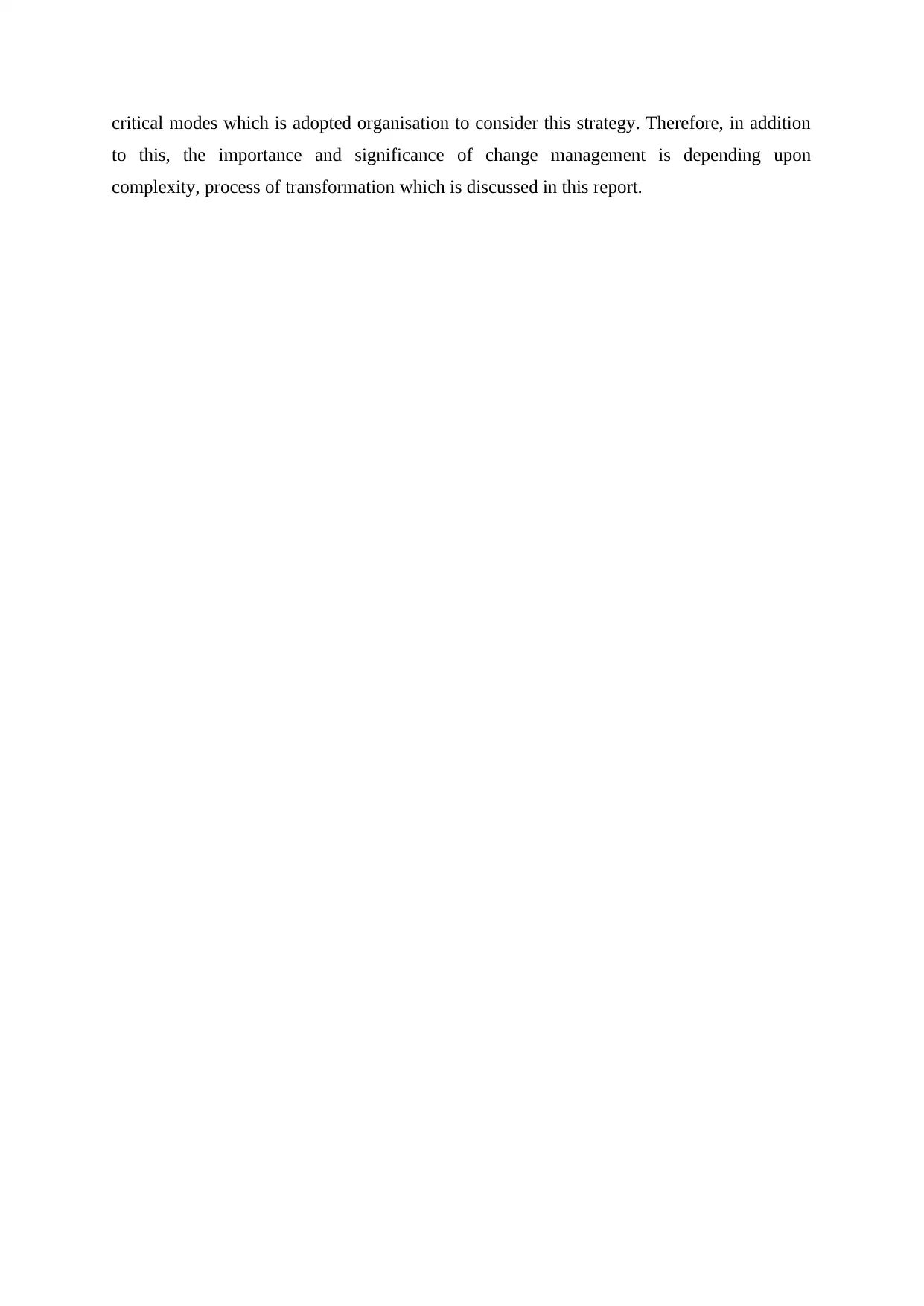
critical modes which is adopted organisation to consider this strategy. Therefore, in addition
to this, the importance and significance of change management is depending upon
complexity, process of transformation which is discussed in this report.
to this, the importance and significance of change management is depending upon
complexity, process of transformation which is discussed in this report.
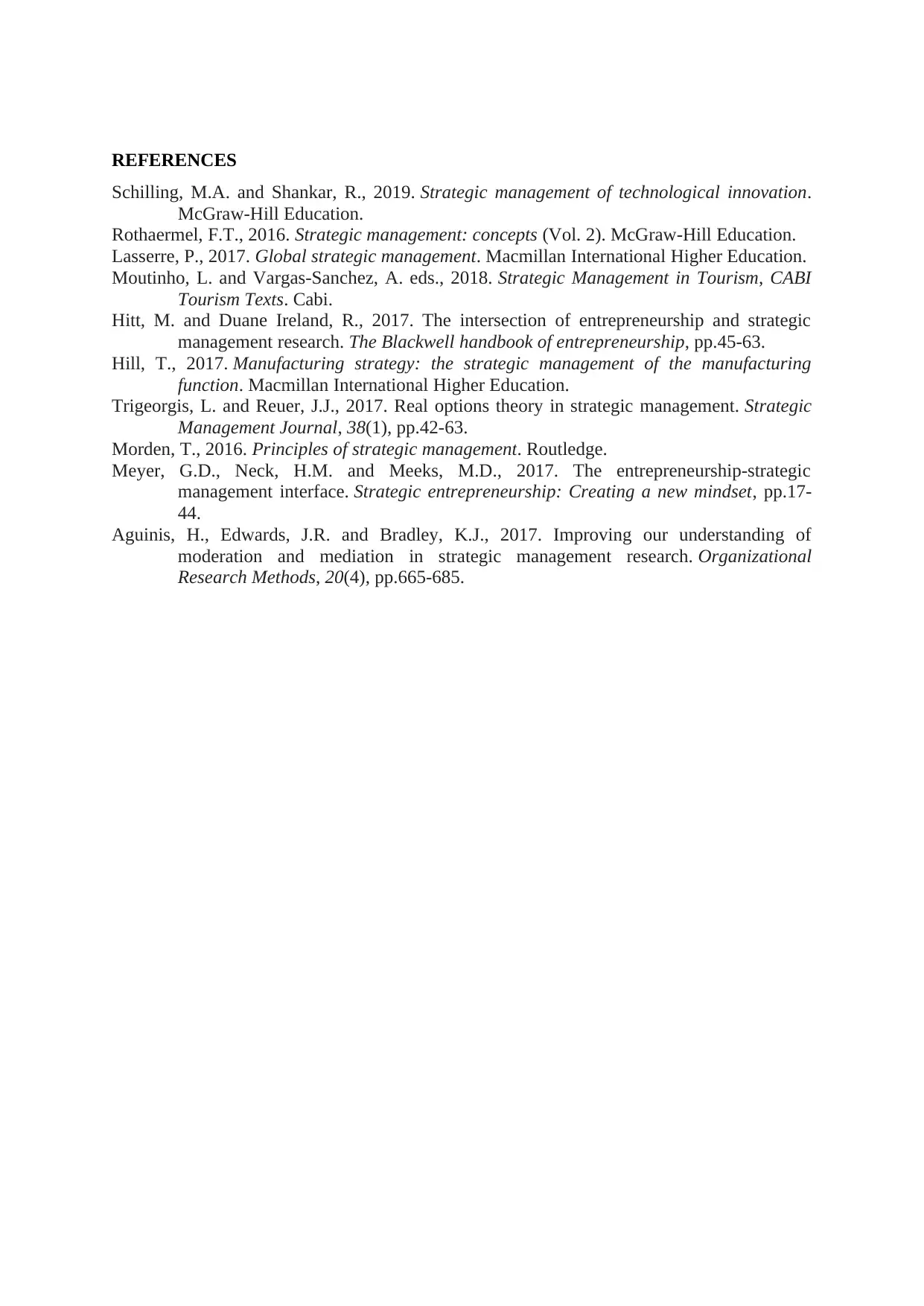
REFERENCES
Schilling, M.A. and Shankar, R., 2019. Strategic management of technological innovation.
McGraw-Hill Education.
Rothaermel, F.T., 2016. Strategic management: concepts (Vol. 2). McGraw-Hill Education.
Lasserre, P., 2017. Global strategic management. Macmillan International Higher Education.
Moutinho, L. and Vargas-Sanchez, A. eds., 2018. Strategic Management in Tourism, CABI
Tourism Texts. Cabi.
Hitt, M. and Duane Ireland, R., 2017. The intersection of entrepreneurship and strategic
management research. The Blackwell handbook of entrepreneurship, pp.45-63.
Hill, T., 2017. Manufacturing strategy: the strategic management of the manufacturing
function. Macmillan International Higher Education.
Trigeorgis, L. and Reuer, J.J., 2017. Real options theory in strategic management. Strategic
Management Journal, 38(1), pp.42-63.
Morden, T., 2016. Principles of strategic management. Routledge.
Meyer, G.D., Neck, H.M. and Meeks, M.D., 2017. The entrepreneurship‐strategic
management interface. Strategic entrepreneurship: Creating a new mindset, pp.17-
44.
Aguinis, H., Edwards, J.R. and Bradley, K.J., 2017. Improving our understanding of
moderation and mediation in strategic management research. Organizational
Research Methods, 20(4), pp.665-685.
Schilling, M.A. and Shankar, R., 2019. Strategic management of technological innovation.
McGraw-Hill Education.
Rothaermel, F.T., 2016. Strategic management: concepts (Vol. 2). McGraw-Hill Education.
Lasserre, P., 2017. Global strategic management. Macmillan International Higher Education.
Moutinho, L. and Vargas-Sanchez, A. eds., 2018. Strategic Management in Tourism, CABI
Tourism Texts. Cabi.
Hitt, M. and Duane Ireland, R., 2017. The intersection of entrepreneurship and strategic
management research. The Blackwell handbook of entrepreneurship, pp.45-63.
Hill, T., 2017. Manufacturing strategy: the strategic management of the manufacturing
function. Macmillan International Higher Education.
Trigeorgis, L. and Reuer, J.J., 2017. Real options theory in strategic management. Strategic
Management Journal, 38(1), pp.42-63.
Morden, T., 2016. Principles of strategic management. Routledge.
Meyer, G.D., Neck, H.M. and Meeks, M.D., 2017. The entrepreneurship‐strategic
management interface. Strategic entrepreneurship: Creating a new mindset, pp.17-
44.
Aguinis, H., Edwards, J.R. and Bradley, K.J., 2017. Improving our understanding of
moderation and mediation in strategic management research. Organizational
Research Methods, 20(4), pp.665-685.
1 out of 9
Related Documents
Your All-in-One AI-Powered Toolkit for Academic Success.
+13062052269
info@desklib.com
Available 24*7 on WhatsApp / Email
![[object Object]](/_next/static/media/star-bottom.7253800d.svg)
Unlock your academic potential
© 2024 | Zucol Services PVT LTD | All rights reserved.




